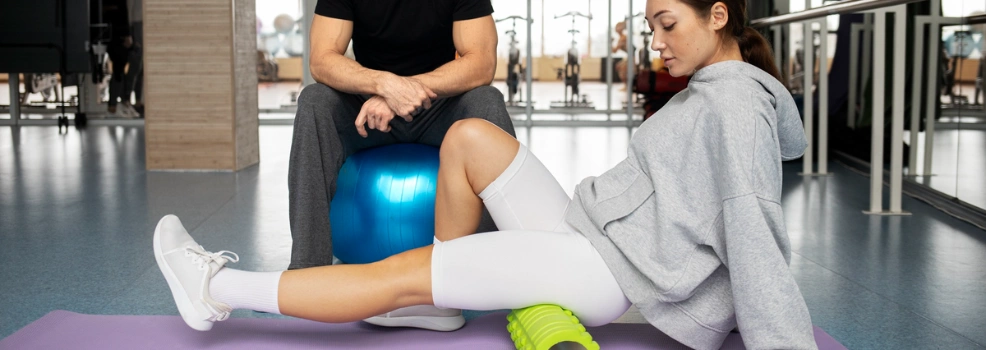Whether you are a recreational or a professional athlete, sports injuries can greatly impact your daily performance and often raise the question: “How long until I can get back to being active?” The uncertainty of recovery time can indeed cause more stress than the injury itself. While physiotherapy in Winnipeg plays a vital role in sports rehabilitation, the recovery time may vary significantly from person to person.
By exploring common sports injuries, the role of physiotherapy treatment for sports injury, expected recovery timelines, and the number of sessions typically required, this guide will help set clear expectations for your rehabilitation journey.
Understanding Common Sports Injuries
Before we move on to the recovery timeline of each sports injury, it is essential to first recognize the most frequently encountered injuries.
Sprains & Strains
These are one of the most common injuries experienced by athletes. Sprains generally occur when ligaments (tissues that connect bones) are stretched or torn. On the other hand, strains mainly affect muscles or tendons due to overstretching or sudden movement. Together, they can account for the most common of all sports-related injuries, particularly affecting the ankle, knee, or wrist.
Dislocations & Meniscus Tears
These injuries can sometimes occur together, mostly in knee injuries. As the name suggests, dislocations happen when bones are forced out of their normal position, requiring urgent care. At the same time, meniscus tears are common in pivoting sports like soccer and basketball.
Fractures
Fractures can range from hairline breaks to complete bone breaks. It is common in high-impact activities like football, soccer, and basketball.
Tendinopathy & Rotator Cuff Injuries
Tendinopathy is tendon inflammation or degeneration, typically from overuse—common in running, jumping, and overhead sports. On the other hand, rotator cuff injuries affect shoulder muscles and are frequent among athletes who perform repetitive overhead motions, like swimmers, weightlifters, and baseball pitchers.
Note: For knee-related overuse conditions, you can learn more in our guide on Patellar Tendinitis vs Patellofemoral Syndrome.
Concussions & Head Injuries
Particularly relevant in contact sports, concussions result from head impacts. While symptom resolution may occur early, physiotherapy treatment may take time, posing risks if athletes return to sports or action prematurely.
ACL Tears
An ACL (anterior cruciate ligament) tear often occurs during rapid direction changes or jumping. These injuries are also common among hockey players in Winnipeg, given the intensity and contact nature of the sport.
The Role of Physiotherapy Treatment in Sports Injury Rehabilitation
Sports physiotherapy in Winnipeg not only speeds healing but also helps ensure your progress is safe, steady, and effective, reducing the risk of setbacks. Here’s how physiotherapists in Winnipeg can help you in each stage of the rehabilitation process:
Assessment & Diagnosis
When an injury occurs, your physiotherapist starts with a comprehensive assessment. The evaluation combines physical assessment, movement analysis, and diagnostic tests, if needed. This step determines the root cause and severity of injury. With the help of such a precise evaluation, therapists make tailored sports rehabilitation exercises, which help speed up recovery while preventing further damage or injury recurrence.
Pain Management & Inflammation Control
In the early stage of physio for sports injury, therapists employ targeted techniques like manual therapy and compression to reduce pain and swelling. Effective management of inflammation helps control intense pain levels and supports tissue recovery, allowing for a comfortable recovery process.
Restoring Range of Motion & Flexibility
Restoring joint mobility and muscle flexibility is essential to avoid stiffness. Sports physiotherapy focuses on targeted stretching, passive mobilizations, and controlled active motion to maintain or regain functional movement. This step ensures that your joints and tissues remain supple and capable of supporting progressive training.
Strengthening & Stability Training
The next step of physio for sports involves muscle strengthening. Once the inflammation subsides, therapists focus on training the muscles around the injured area and joint stability. These professionals will create customized resistance exercises, which help rebuild muscle power and coordination.
Functional Training & Sports-Specific Exercises
As the rehabilitation progresses, your therapists involve functional training that mimics the physical demands of the athlete’s sport. Through sport-specific drills and agility exercises, individuals can return to sport safely, lowering the risk of re-injury. If you are looking for “sports physiotherapy near me,” check the clinics’ reviews to make informed decisions.
Recovery Timelines for Common Sports Injuries
While a structured approach is important for effective sports rehabilitation, the actual recovery timeline may vary depending on the type and severity of each injury. It is important to note that the durations mentioned below are not fixed. Always consult an expert. They will guide you on the accurate recovery timeline and physiotherapy session cost in Winnipeg.
- Muscle and Soft-Tissue Injuries (Mild Sprains & Strains): Controlled activity often shows improvements within a few weeks. This duration is enough to regain movement and begin basic strengthening under professional supervision.
- Ligament Injuries (Moderate Sprains): Ligament recovery may take 6 to 12 weeks, as healing tissues require gradual proprioceptive training to regain stability and functional strength.
- Bone Fractures: Recovery from a fracture typically takes 6 to 8 weeks, depending on the severity of the fracture. Athletes should incorporate physiotherapy treatment to rebuild mobility and strength in the healed bone.
- ACL (Anterior Cruciate Ligament) Tears: Recovery from ACL tears, especially post-reconstruction, can range from 6 to 12 months. This timeline allows for tissue healing, graft maturation, and functional readiness for return-to-sport demands.
Conclusion
Recovery from sports injuries with physiotherapy is never a one-size-fits-all process. The duration depends on the type of injury, your overall health, and commitment to treatment. With the right guidance, physiotherapy in Winnipeg not only speeds healing but also strengthens the body to prevent re-injury, ensuring athletes can return to sport safely. Whether it is a mild sprain, physiotherapy for knee pain, or a complex ligament tear, structured physio for sports injury can make the difference. Choose Bridgwater Physiotherapy as your one-step solution for expert care, faster recovery, and lasting results. Book your sports physiotherapy session today!


